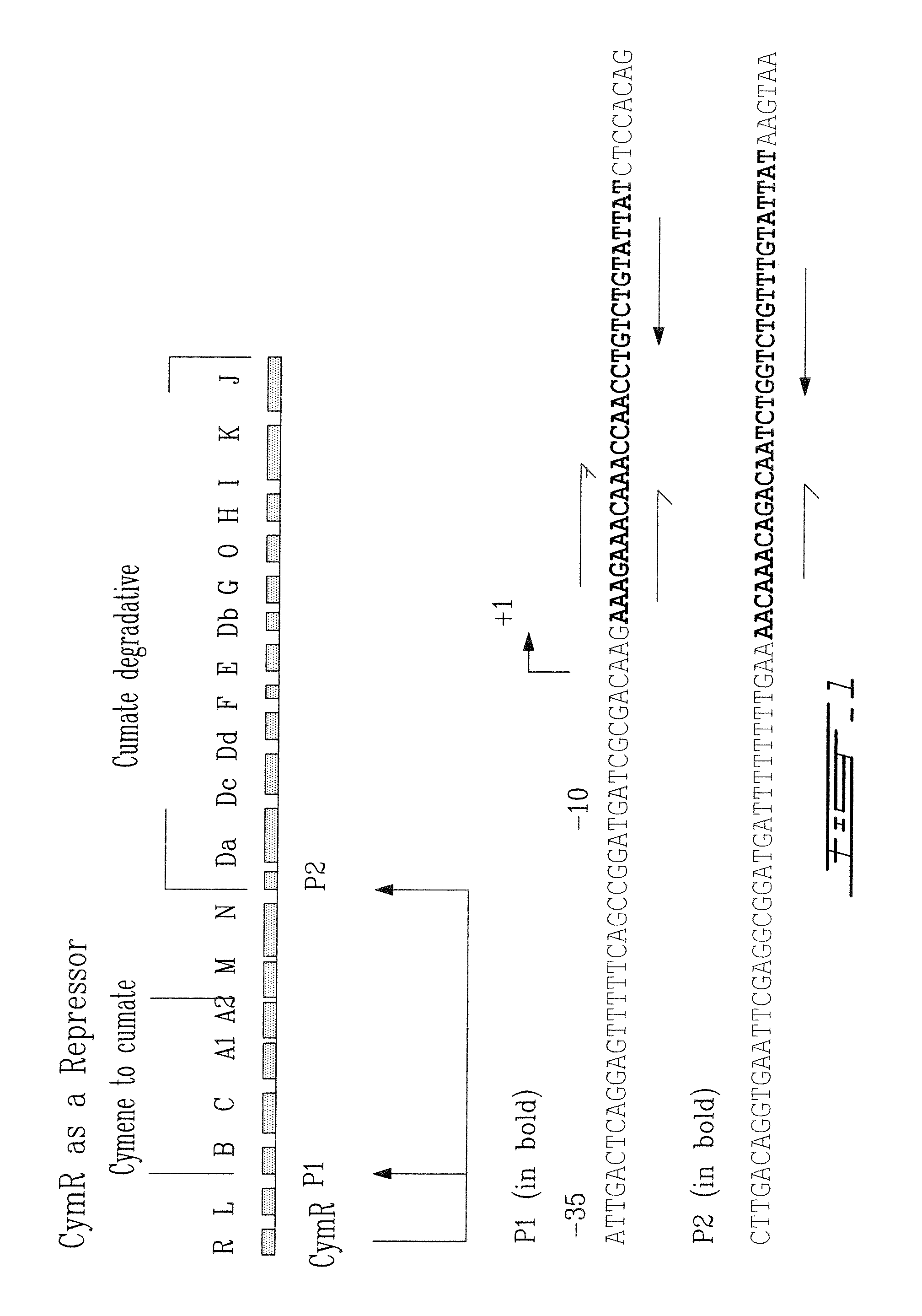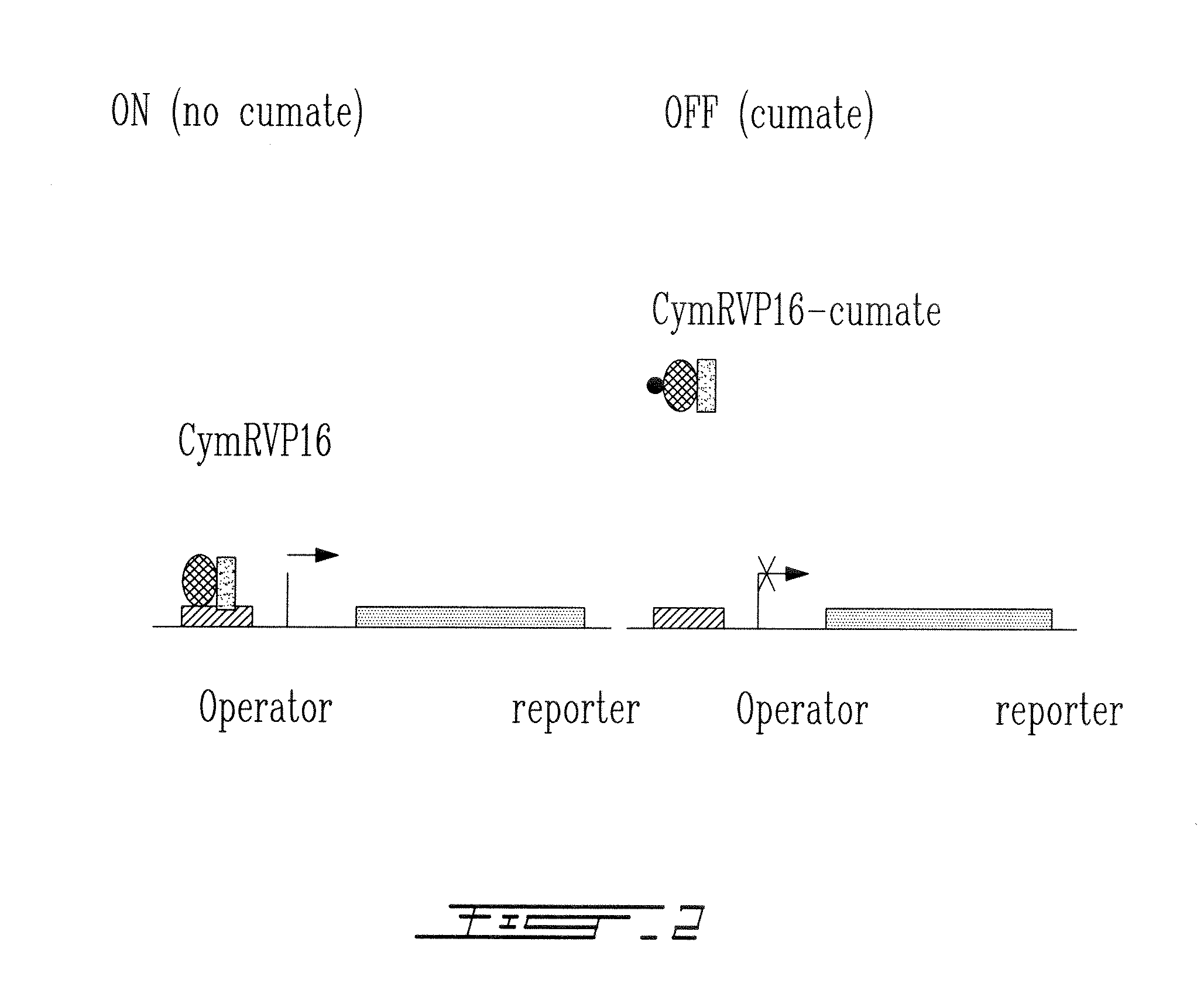System for inducible expression in eukaryotic cells
a technology of inducible expression and eukaryotic cells, which is applied in the field of new “ geneswitch” (cumate-inducible switch) for mammalian cells, can solve the problem that the cell cannot tolerate the expression of foreign proteins well, and achieve the effect of reducing the number of inducible switch genes
- Summary
- Abstract
- Description
- Claims
- Application Information
AI Technical Summary
Benefits of technology
Problems solved by technology
Method used
Image
Examples
example 1
Strategy 1
Components of the Switch
The Activator
[0138]A hybrid molecule (CymR-VP16) has been created that activates transcription once bound to DNA (FIG. 2).
The Reporter Construct
[0139]The reporter construct consists principally of three components: the CymR binding site (operator sequence), the basal promoter element and a reporter gene (β-galactosidase) such that the operator sequence is inserted upstream of the start site. (FIG. 2).
The Cumate Switch in 293 Cells
[0140]To test the system, reporter and activator constructs as described in Example I above, were co-transfected into 293 cells by the calcium-phosphate technique. A plasmid carrying the secreted alkaline phosphatase coding sequence under the control of a constitutive promoter was included in all transfections and seap activity in the cell culture medium was used to normalize for transfection efficiency.
[0141]FIG. 4 shows the results of a typical experiment. Reporter constructs (pAdCR5LacZ), when transfected alone produced ...
example ii
Strategy 2
Components of the Switch
The Repressor
[0154]The repressor is the cumate repressor CymR as found in recombinant plasmid pTNP-47.
The Reporter Construct
[0155]The reporter construct consists principally of three components: the CymR binding site (operator sequence, see FIG. 1), the basal promoter element and a reporter gene (β-galactosidase) such that the operator sequence is inserted downstream of the start site. (FIG. 3).
293 Cells
[0156]When 293 cells were transfected with 5 μg of either pAdCMV5-Og-LacZ or pAdCMV5-Os-LacZ on their own, both vectors expressed reporter activity comparable to that of from an unmodified CMV5 promoter. Expression from the pAdCMV5-Os-LacZ construct is actually slightly higher (165%) than that from the CMV5 construct. Expression from the pAdCMV5-Og-LacZ construct is indistinguishable from that of the CMV5 control. Co-transfection of 0.25 μg of repressor plasmid (pAdCymR) reduced expression from both the pAdCMV5-Os-LacZ and the pAdCMV5-Og-LacZ constru...
PUM
| Property | Measurement | Unit |
|---|---|---|
| pH | aaaaa | aaaaa |
| concentration | aaaaa | aaaaa |
| concentration | aaaaa | aaaaa |
Abstract
Description
Claims
Application Information
 Login to View More
Login to View More - R&D
- Intellectual Property
- Life Sciences
- Materials
- Tech Scout
- Unparalleled Data Quality
- Higher Quality Content
- 60% Fewer Hallucinations
Browse by: Latest US Patents, China's latest patents, Technical Efficacy Thesaurus, Application Domain, Technology Topic, Popular Technical Reports.
© 2025 PatSnap. All rights reserved.Legal|Privacy policy|Modern Slavery Act Transparency Statement|Sitemap|About US| Contact US: help@patsnap.com



